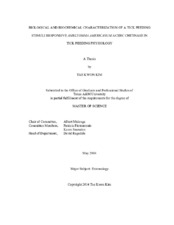| dc.description.abstract | Without successful feeding, ticks can neither cause damage to their host nor transmit disease agents. Thus, a deeper understanding of tick physiology as a means to discover weaknesses that can be targeted for tick control is needed. In a previous study, 40 genes were discovered that are differentially up regulated in Amblyomma americanum (Aam) (Linnaeus) females when exposed to feeding stimuli. The purpose of this study was to biologically and biochemically characterize one of the 40 candidate genes, a putative acidic chitinase (Ach), to understand its role(s) and significance in regulating tick feeding physiology. This research has shown that A. americanum expresses two putative AamAch isoforms [long (L) and short (S)], both of which are classified into the glycosyl hydrolase 18 (GH-18) family. Members of the GH-18 are involved in regulating multiple functions including nutrition processes in bacteria, morphogenesis in yeast and fungi, pathogen attack in plants, molting in insects, and inflammation and tissue remodeling in mammals. Spatial and temporal mRNA transcript analyses show that putative AamAch-L and AamAch-S are ubiquitously expressed, with highest transcript abundance post-attachment observed at 72h in all tissues, and at 96h in the salivary gland. Pichia pastoris-expressed recombinant AamAch-L was glycosylated, consistent with molecular analysis that predicted N- and O-linked glycosylation sites. Substrate hydrolysis analysis indicated that rAamAch-L does not apparently have chitinase activity. RNAi mediated silencing of AamAch mRNA apparently caused loosening or weakening of the tick cement plug at the feeding site. Animals injected with AamAch-dsRNA bled around mouthparts, and were loosely attached on its rabbit host in that they easily detached with a light touch. The putative AamAch is therefore potentially involved in mediating tick attachment onto host skin. This thesis research advances our knowledge on the understanding of the molecular basis of tick feeding physiology and provides new information on the diverse physiological role of acidic chitinase-like proteins. | en |


